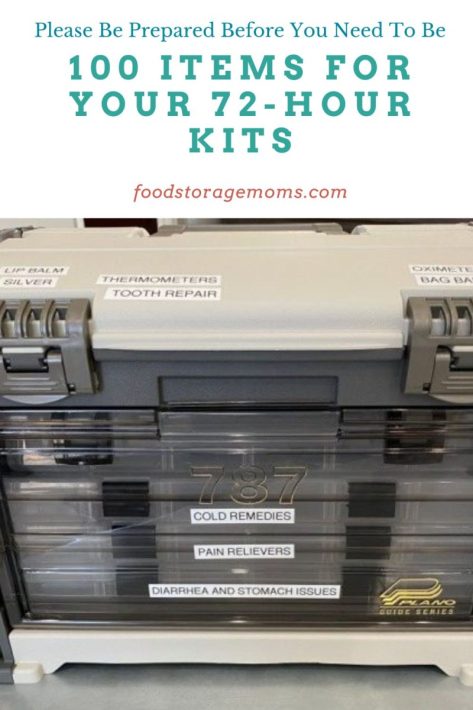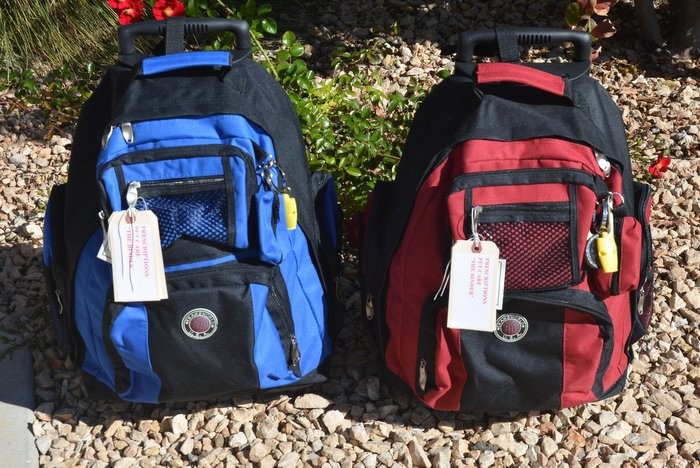Right here’s a complete, organized listing of 100 Gadgets For Your 72-Hour Kits — the whole lot you may have to survive and keep comfy for no less than three days in an emergency.
A 72-hour equipment (additionally known as a go-bag or bug-out bag) ought to maintain you for 3 days throughout an evacuation, catastrophe, or emergency. Every member of the family, even pets, ought to have their very own equipment for survival, consolation, hygiene, and peace of thoughts.
100 Gadgets For Your 72-Hour Kits
My favourite gadgets to place in my luggage are on this restricted listing, however you’ll get the drift.
First Support Kits (these slot in your luggage)


100 Gadgets For Your 72-Hour Kits
Meals & Water
The precedence in any emergency is hydration and nourishment. Your physique wants a gradual provide of power to remain alert and decisive.
- Bottled water (1 gallon per individual per day). Please notice: I want 4 gallons per individual per day.
- Water purification tablets
- Moveable water filter (LifeStraw or Sawyer Mini)
- Collapsible water container
- Canned meals (stews, soups, chili)
- Canned fruit or greens
- Prepared-to-eat meals (MREs)
- Vitality or protein bars
- Path combine or nuts
- Prompt oatmeal packets
- Peanut butter
- Crackers
- Powdered milk
- Prompt espresso or tea
- Laborious sweet or gum
- Disposable utensils
- Can opener (handbook)
- Small cooking pot or pan
- Tenting range or strong gasoline range, Kelley Kettle
- Gas canisters (propane, butane, or tabs) Butane Range, and Canisters
First Support & Well being
A well-stocked first assist equipment can forestall infections and save lives throughout a disaster.
- Adhesive bandages (varied sizes)
- Sterile gauze pads
- Medical tape
- Antiseptic wipes
- Antibiotic ointment
- Tweezers
- Scissors
- Ache relievers (ibuprofen, acetaminophen)
- Antihistamines (for allergic reactions)
- Burn cream or gel
- Prompt chilly packs
- Elastic bandage wrap
- Nitrile gloves
- Thermometer
- Prescription medicines (3-day provide minimal)
- Eye drops
- Lip balm
- Face masks (N95 if doable)
- Hand sanitizer
- Small first-aid handbook
Clothes & Heat
Your clothes selections can imply the distinction between consolation and hazard in excessive circumstances.
- Further set of garments (season-appropriate)
- Heat jacket or coat
- Rain poncho
- Sturdy sneakers or boots
- Further socks (no less than two pairs)
- Hat and gloves
- Bandana or scarf
- Mylar emergency blanket
- Sleeping bag
- Compact sleeping pad
This stuff assist with shelter constructing, signaling, and security.
- Multi-tool or Swiss Military knife
- Duct tape
- Rope or paracord (no less than 25 ft)
- Flashlight (LED most well-liked)
- Further batteries
- Photo voltaic or hand-crank lantern
- Whistle
- Compass
- Waterproof matches
- Lighter
- Firestarter (cotton balls & petroleum jelly)
- Small shovel or trowel
- Pocket noticed or folding knife
- Zip ties
- Glow sticks
- Tremendous glue
- Security pins
- Small stitching equipment
- Trash luggage (heavy-duty)
- Carabiners or clips
Hygiene & Sanitation
Cleanliness helps keep morale and prevents illness, particularly in group or shelter settings.
- Toothbrush & toothpaste
- Biodegradable cleaning soap
- Moist wipes
- Towel or washcloth
- Deodorant
- Comb or brush
- Razor & shaving cream
- Rest room paper
- Female hygiene merchandise
- Small mirror
- Plastic luggage (for waste)
- Moveable rest room or disposable luggage
- Hand sanitizer (further bottle)
- Laundry cleaning soap sheets or powder
- Nail clippers
Communication & Documentation
Keep knowledgeable and related when networks are down.
- Battery-powered or hand-crank radio
- Cellular phone charger (photo voltaic or crank kind)
- Further energy financial institution
- Listing of emergency contacts
- Copies of ID, insurance coverage, and medical information (in waterproof pouch)
- Money (small payments)
- Native maps
- Pocket book and pen/pencil
- Sharpie marker
- Small Bible or inspirational e book
Just a few consolation gadgets go a great distance in lowering stress throughout emergencies.
- Deck of playing cards or small recreation
- Small e book or puzzle
- Earplugs
- Light-weight tent or tarp
- Pet meals and provides (if relevant)
When Would You Want To Use Your 72-Hour Equipment
1. Pure Disasters
Your 72-hour equipment is crucial if it is advisable to evacuate shortly or shelter in place throughout:
- Earthquakes: Energy, water, and roads could also be unavailable for days.
- Hurricanes or tornadoes: You might want to go away your house all of a sudden or keep in a shelter.
- Flooding or wildfires: Usually requires speedy evacuation with little warning.
- Extreme winter storms: Roads could shut and energy outages can final for days.
2. Energy Outages or Utility Failures
If electrical energy, water, or fuel service is interrupted for various hours:
- Your equipment supplies flashlights, batteries, meals, water, and heat.
- It helps you keep comfy and protected with no need to go away your house.
3. Evacuation Orders
Authorities could inform you to go away your space attributable to:
- Chemical spills or industrial accidents
- Practice derailments
- Civil unrest or security threats
Having your equipment packed enables you to depart inside minutes with the whole lot important — ID, money, meds, and meals.
4. Stranded Whereas Touring
Should you’re caught in your automotive throughout a snowstorm or a freeway closure:
- A small 72-hour equipment (stored in your trunk) supplies blankets, meals, and light-weight till assist arrives.
5. Household or Medical Emergencies
In case you should depart dwelling all of a sudden, for instance, to stick with relations or go to a hospital, your 72-hour equipment ensures you’ve gotten:
- Prescriptions, hygiene provides, garments, cellphone chargers, and private gadgets are able to go.
6. Shelter-In-Place Eventualities
Typically, it’s safer to keep inside your house fairly than evacuate, like after a chemical launch or throughout a widespread energy outage.
Your 72-hour equipment helps you maintain your self for 3 days with out leaving your house.
FAQs About 72-Hour Kits
1. What’s a 72-hour equipment?
A 72-hour equipment (or go-bag) is a transportable emergency equipment designed to maintain you for 3 days with important meals, water, medical provides, and survival necessities.
2. Why 72 hours?
Most disaster-response organizations goal to achieve victims inside 72 hours, so that you want sufficient provides to remain self-sufficient till assist arrives.
3. How usually ought to I replace my equipment?
Examine and change expired meals, water, and medicines each 6 months. Replace clothes and equipment for the season.
4. Ought to every member of the family have their very own equipment?
Sure, tailor every equipment for age, measurement, and medical wants. Even pets ought to have a mini 72-hour equipment.
5. The place ought to I retailer my 72-hour kits?
Please maintain them in an simply accessible place close to your entrance door, automotive trunk, or emergency shelter space.
1. Emergency Shelters (Run by Crimson Cross, FEMA, or Native Companies)
After most disasters, emergency shelters are among the many first to open.
They’re often positioned in:
- Colleges
- Group facilities
- Church buildings
- Conference facilities
- Sports activities arenas
Tip:
Hearken to native radio or emergency alerts for official shelter areas.
By no means assume your native faculty or church will open robotically — some could also be broken or inaccessible.
2. Hospitals and Medical Facilities
Should you or a member of the family is injured, go to the nearest hospital, pressing care, or first-aid station arrange by native responders.
Throughout large-scale disasters, short-term medical tents or cell items could also be positioned in:
- Highschool parking tons
- Fairgrounds
- Sports activities complexes
Convey your ID, insurance coverage information, and medicines out of your 72-hour equipment, if doable.
3. Police or Hearth Stations
These function command facilities throughout emergencies.
You’ll be able to go there in case you:
- Want security from hazard or crime
- Are misplaced or separated from your loved ones
- Have to report lacking individuals or property injury
Be aware: They could not provide shelter, however they’ll direct you to out there sources.
4. Designated Evacuation Facilities
Counties usually have pre-approved evacuation buildings which might be constructed to face up to native hazards (like earthquakes or hurricanes).
Examples embody:
- Metropolis recreation facilities
- Municipal buildings
- Armories
You’ll find your nearest evacuation facilities by checking your:
5. Religion-Based mostly or Nonprofit Shelters
Many church buildings, mosques, temples, and neighborhood organizations open their doorways throughout disasters — particularly if authorities shelters are full.
Teams like:
- The Salvation Military
- Catholic Charities
- Local people coalitions
These usually present meals, water, and short-term lodging.
6. Resorts or Motels (If Protected and Reasonably priced)
Should you can afford it and journey is protected, a lodge can provide privateness and luxury whereas infrastructure is restored.
All the time test:
- Energy availability
- Clear water entry
- Security of the encompassing space
If doable, it’s greatest to evacuate to somebody you belief who lives exterior the catastrophe zone.
That is the place your household emergency communication plan is available in.
Ensure each member of the family is aware of:
- The handle and cellphone quantity of your out-of-area contact
- Tips on how to ship updates through textual content (texts usually work when calls fail)
8. Final Resort: Open Areas or Short-term Camps
If all else fails and buildings are unsafe, go to:
- Open parks
- College fields
- Giant parking tons
These areas are sometimes used for:
- Helicopter landings
- Short-term assist stations
- Provide drop zones
Keep till authorities set up an official shelter.
72-Hour Luggage Wanted For Survival
PRINTABLE: 100 Gadgets For Your 72 Hour Equipment
100_Items_For_Your_72_Hour_Kits_Checklist
Ultimate Phrase
After a catastrophe:
Keep calm and test for speedy hazard (fuel leaks, fires, unstable constructions).
Hearken to official directions through radio or cellphone alerts.
Go to a delegated protected constructing, don’t wait till dusk.
Convey your 72-hour equipment with you wherever you go. Your 72-hour equipment is your lifeline when catastrophe strikes, whether or not you’re sheltering in place or evacuating. Overview and rotate provides each 6 months to make sure the whole lot stays recent and purposeful. Customise kits for every member of the family’s age, well being, and private wants. Might God bless this world, Linda


